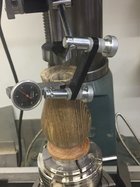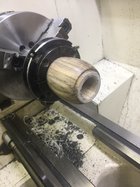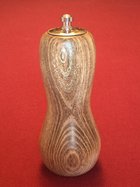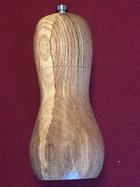This post is prompted by comments made in this thread https://www.aawforum.org/community/...r-healing-cracks-sometimes.18722/#post-189097
A week ago I started a combo salt shaker/pepper-mill as a Christmas gift for a grandson. I started with a chunk of hackberry that looked interesting. As I finished boring the 1-1/16" hole through the center I noticed that the forstner bit and extension was wobbling. I didn't realize that the stage was set for failure.
I continued with the piece deciding on and turning the outside. I was pleased with the flow of the curves and wanted to preserve them and the grain continuity. I carefully parted the piece into a top and bottom. I didn't want a feature at the joint and was confident that I didn't need one to mask any problems.
Fast forward to assembly of the mechanism. That's when I discovered how off badly the hole was messed up. Not only did the top move out of alignment by at least 1/16" as it was rotated it also wobbled as the hole was off-axis to the turning. It should have went into the firewood box at that time. But with the deadline and liking everything else about it I decided to fix it.
That process involved my metal lathe and mill to rebore the center hole and bearing surface hole true to the turning. Of course the bearing surface was now oversize so I used a piece of PVC pipe to make a collar to glue on to the mechanism and fit it to the new oversized hole.
Anyway the hole process (spelling and pun intended) took a couple days to complete. The top now rotates with less than 0.010" runout. I was happy with the result. My grandson was thrilled with it. Was it worth it? I'm still undecided. It was definitely a learning process.
A week ago I started a combo salt shaker/pepper-mill as a Christmas gift for a grandson. I started with a chunk of hackberry that looked interesting. As I finished boring the 1-1/16" hole through the center I noticed that the forstner bit and extension was wobbling. I didn't realize that the stage was set for failure.
I continued with the piece deciding on and turning the outside. I was pleased with the flow of the curves and wanted to preserve them and the grain continuity. I carefully parted the piece into a top and bottom. I didn't want a feature at the joint and was confident that I didn't need one to mask any problems.
Fast forward to assembly of the mechanism. That's when I discovered how off badly the hole was messed up. Not only did the top move out of alignment by at least 1/16" as it was rotated it also wobbled as the hole was off-axis to the turning. It should have went into the firewood box at that time. But with the deadline and liking everything else about it I decided to fix it.
That process involved my metal lathe and mill to rebore the center hole and bearing surface hole true to the turning. Of course the bearing surface was now oversize so I used a piece of PVC pipe to make a collar to glue on to the mechanism and fit it to the new oversized hole.
Anyway the hole process (spelling and pun intended) took a couple days to complete. The top now rotates with less than 0.010" runout. I was happy with the result. My grandson was thrilled with it. Was it worth it? I'm still undecided. It was definitely a learning process.




